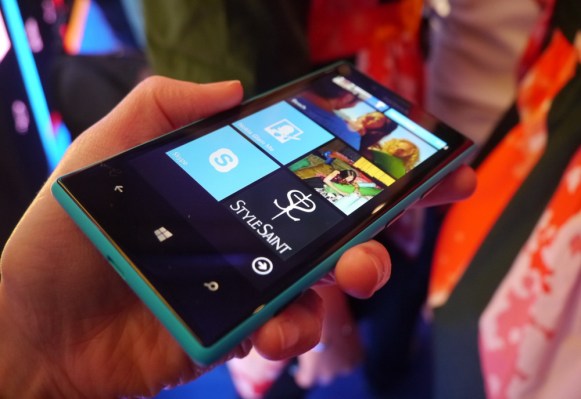In what is likely to be Nokia’s last quarterly earnings before it hands off its mobile phone making business to Microsoft, the Finnish mobile maker has reported lower sales of Lumia devices in its Q4. The company also reported a non-IFRS operating profit of €408 million — but based mainly on its NSN equipment business. So the decision to cut loose its mobile phone making business looks to be vindicated by these results.
Nokia’s adjusted operating profit in the quarter was €274 million — €243 million of which came from NSN. Its non-IFRS EPS was €0.08. Revenue was €3.476 billion.
In a preview of the earnings, TC’s Alex Wilhelm suggested Nokia should easily sell more than 10 million Lumias in what was after all the holiday quarter.
In the event Nokia has not broken out a figure for sales of the Windows Phone devices in its Q4 earnings report — noting only a decline in Smart Devices net sales (and also in basic Mobile Phones net sales), so presumably it sold less than the 8.8 million Lumia reported last quarter.
Update: According to the WSJ Nokia has now confirmed it sold 8.2 million Lumias in the quarter. Full-year 2013 Lumia sales stand at 30 million units.
The year-on-year decline in discontinued operations net sales in the fourth quarter 2013 was primarily due to lower Mobile Phones net sales and, to a lesser extent, lower Smart Devices net sales. Our Mobile Phones net sales were affected by competitive industry dynamics, including intense smartphone competition at increasingly lower price points and intense competition at the low end of our product portfolio. Our Smart Devices net sales were affected by competitive industry dynamics including the strong momentum of competing smartphone platforms, as well as our portfolio transition from Symbian products to Lumia products.
In its previous earnings report, for its fiscal Q3, Nokia reported a surprise profit of €118 million ($160 million), with 8.8 million Lumia smartphones sold in the quarter — up from 7.4 million Lumias sold in its Q2. Nokia made an operating loss of €115 million ($156 million) in that quarter.
In its Q1 Nokia reported 5.6 million Lumias sold — so sales of its Lumia devices were gradually increasing, quarter on quarter. Its Q4 results reverse that trend — and make Nokia’s decision to hand-off its phone business to Microsoft look like a solid one.
Back in September Nokia announced it would sell substantially all of its phone making business to Microsoft. That transaction is still expected to close in the first quarter of this year.
Commenting on the Q4 results in a statement, Risto Siilasmaa, Nokia Chairman and interim CEO said: “The fourth quarter of 2013 was a watershed moment in Nokia’s history. Having received overwhelmingly strong support from our shareholders at our extraordinary general meeting in November for the sale of our phones business to Microsoft, we are diligently working towards defining Nokia’s future direction. I am pleased with the progress we have made thus far in our strategy evaluation and excited by the opportunities ahead for each of our three continuing businesses: NSN, HERE and Advanced Technologies.
“During the fourth quarter, Nokia’s continuing businesses produced a healthy underlying operating margin of 12%. While the first quarter of the year is seasonally weak for our continuing operations, we continue to expect the closing of the Microsoft transaction to significantly improve Nokia’s earnings profile.”
Nokia, once the world’s biggest mobile maker, suffered a huge fall from favour, following its February 2011 decision to switch to Microsoft’s Windows Phone platform for smartphone devices and away from its own software. Its total smartphone sales declined for the first time in its Q1 that year, and that decline was followed by a run of loss-making quarters as Nokia transitioned from Symbian to Windows Phone, a task made harder by shrinking cash reserves and a series of deep and damaging job cuts.
Finally, last fall, Nokia made the decision to cut its losses and exit the phone-making game — selling the division to Microsoft for €3.79 billion (and agreeing a patent licensing deal for a further €1.65 billion) — to concentrate its efforts on other portions of its business: namely its NSN networking division; HERE maps; its patents & ongoing R&D efforts under a division called Advanced Technologies.
Nokia said today that its NSN business is now “fundamentally different” to the one it started restructuring two years ago. The division posted an IFRS-adjusted profit of €243 million for the quarter, and looks poised to be the focal engine for Nokia’s future growth, post-phones.
Its HERE maps division posted an IFRS-adjusted profit of €18 million — making it a very small fish in Nokia’s pond right now (hence the talk of “long-term transformational growth opportunities”). Nokia added that it is planning to increase investment levels in HERE in 2014.
Advanced Technologies, responsible for Nokia’s IP licensing efforts, posted an IFRS-adjusted profit of €65 million.
For the Windows Phone platform, the last three+ years has been a long and bloody road to building out its stated aim of becoming a third ecosystem to compete with Google’s Android and Apple’s iOS. Nokia’s phone-making business is undoubtedly the biggest casualty of that effort (along with Nokia’s homegrown Symbian platform — formerly the largest global smartphone OS).
However a drop in Lumia sales — even a small dip — in a holiday quarter is undoubtedly a blow for Microsoft’s mobile ambitions as it prepares to take over Nokia’s mobile making division. It’s not the Windows Phone momentum story the new Microsoft CEO will have been wanting to shout about when he or she takes over.
